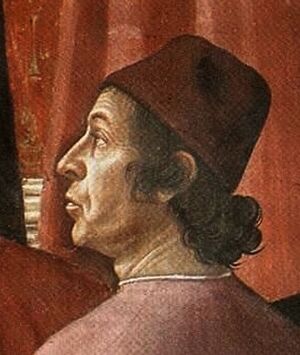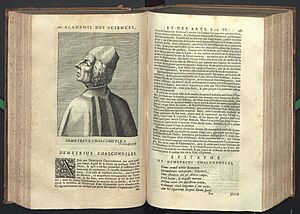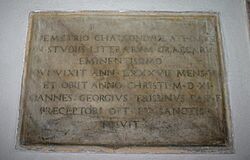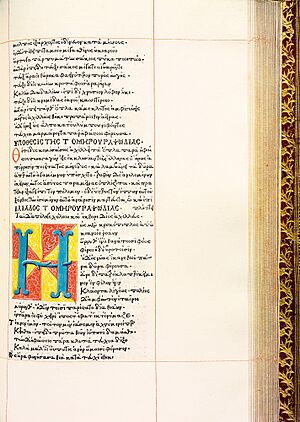Demetrios Chalkokondyles facts for kids
Quick facts for kids
Demetrios Chalkokondyles
Δημήτριος Χαλκοκονδύλης |
|
|---|---|

Chalkokondyles, detail of Zachariah in the Temple by Domenico Ghirlandaio. Fresco. Santa Maria Novella, Cappella Tornabuoni, Florence, Italy. 1486–1490.
|
|
| Born | August 1423 Athens, Duchy of Athens |
| Died | 9 January 1511 (aged 87) Milan, Duchy of Milan |
| Occupation | Scholar, politician, diplomat, philosopher |
| Nationality | Greek |
| Literary movement | Renaissance |
| Relatives | Laonikos Chalkokondyles |
Demetrios Chalkokondyles (born August 1423, died January 9, 1511) was a very important Greek scholar. He taught in Italy for more than 40 years. He was one of the last Greek humanists to teach Greek literature at major Italian universities. These included the University of Padua, University of Florence, and University of Milan.
Demetrios Chalkokondyles helped bring back interest in ancient Greek writings in the Western world. He published the first printed versions of famous works. These included the epic poems of Homer (in 1488), the speeches of Isocrates (in 1493), and the Suda lexicon (a kind of ancient encyclopedia) in 1499.
Contents
His Early Life and Journey
Demetrios Chalkokondyles was born in Athens, Greece, in 1423. His family was one of the most important in Athens. He was also the cousin of Laonikos Chalkokondyles, who wrote about the fall of Constantinople.
His family faced difficulties from the rulers of Florence. Because of this, they moved to the Peloponnese region of Greece. In 1447, Demetrios moved to Italy. He arrived in Rome in 1449. There, a powerful church leader named Cardinal Bessarion became his supporter.
Demetrios studied with Theodorus Gaza, another famous Greek scholar. Later, he gained the support of Lorenzo de Medici, a very powerful and rich leader in Florence. Demetrios even tutored Lorenzo's sons. He spent the rest of his life in Italy, teaching Greek language and philosophy.
A Great Teacher in Italy
Demetrios Chalkokondyles was known for his amazing teaching. One of his students described his lectures in Perugia in 1450:
A Greek has just arrived, who has begun to teach me with great pains, and I to listen to his precepts with incredible pleasure, because he is Greek, because he is an Athenian, and because he is Demetrius. It seems to me that in him is figured all the wisdom, the civility, and the elegance of those so famous and illustrious ancients. Merely seeing him you fancy you are looking on Plato; far more when you hear him speak.
Many important people were his students. These included Janus Lascaris, Poliziano, and even Leo X, who later became Pope.
In 1463, Demetrios became a professor at the University of Padua. Later, in 1479, he moved to Florence. There, he took over the Greek Literature department at the university. He was asked to come to Florence by Lorenzo de Medici.
Helping Greece
Demetrios Chalkokondyles wrote many speeches and papers. In these, he called for his homeland, Greece, to be freed from the Ottoman Turks. In 1463, he asked Venice and "all of the Latins" (meaning Western Europeans) to help the Greeks. He said it was a debt they owed. He reminded them how the Byzantine Greeks had helped Italy against the Goths a long time ago.
"Just as she [Greece] had empended in their behalf [the Latins] all of her most precious and outstanding possessions liberally and without any parsimony, and had restored with her hand and force of arms the state of Italy, long ago oppressed by the Goths, they [the Latins] should in the same way now be willing to raise up prostrate and afflicted Greece and liberate it by arms from the hands of the barbarians."
While teaching in Florence, Demetrios prepared Homer's works for printing. This was a huge achievement. He also helped another scholar, Marsilio Ficino, translate the writings of Plato into Latin. A famous German scholar, Johannes Reuchlin, was one of his students in Florence. He also taught Alessandra Scala, a talented poet.
Demetrios Chalkokondyles got married in 1484 when he was 61 years old. He had ten children. Later, a ruler named Ludovico Sforza invited him to Milan. Demetrios moved there in 1491 or 1492 and taught until he passed away in 1511.
His Important Books and Works
Demetrios Chalkokondyles wrote a grammar handbook in Ancient Greek. Its full title was "Summarized Questions on the Eight Parts of Speech With Some Rules." He also translated Galen's book on Anatomy into Latin.
First Printed Editions
As a scholar, Demetrios Chalkokondyles was famous for publishing the editio princeps (which means the very first printed edition) of several important Greek texts:
- The complete works of Homer (Florence, 1488). This was the first Greek book ever printed in Florence.
- The speeches of Isocrates (Milan, 1493).
- The Byzantine Suda lexicon (a large dictionary and encyclopedia from the Byzantine Empire) (1499).
The Greek letters used to print Homer's works in 1488-1489 were created by a Cretan printer named Demetrius Damilas. He based them on the handwriting of another scribe, Michael Apostolis.
See also
- Chalkokondyles family
- Greek scholars in the Renaissance




